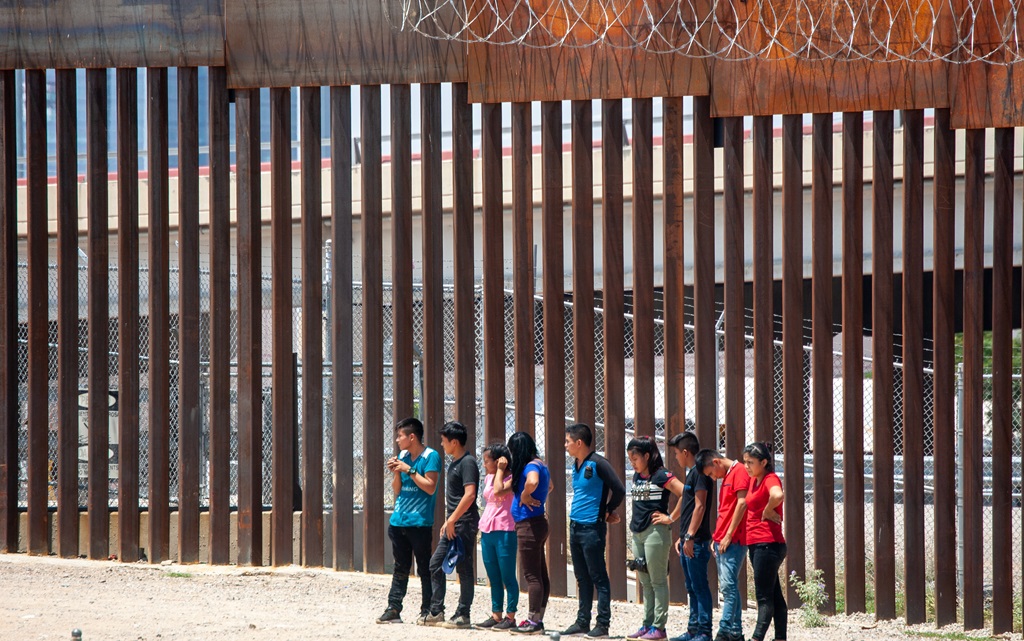Border crossings are at their lowest in four years. Is the Biden administration’s executive action working as intended—or is there another factor at play?
Apprehensions at the U.S.-Mexico border spiked to a record 250,000 in December 2023, but they’ve been falling since then. Beginning in January 2024, a crackdown by Mexico with the goal of “wearing out” migrants has made it harder for people to get to the U.S. border. As a result, border apprehensions have dropped every month of 2024 so far.
This decline only accelerated in June, when the Biden administration instituted a new rule which has led Border Patrol to turn away thousands of asylum seekers. This precipitous drop has sent border crossings to the lowest level in four years. It also reflects the fragile state of asylum seekers, caught in an increasingly tight vise between state pressure and rising desperation.
Mexico’s role in border crossings
Border apprehensions first began dropping this year after the Biden administration went to Mexico in the last days of 2023 and demanded action. In response, Mexico began sweeping northern border towns through “decompression” operations, rounding up thousands of migrants waiting to cross into the United States. Because the Mexican Supreme Court held in 2023 that migrants can only be held in immigration detention centers for 36 hours, Mexico’s operations largely consist of arresting migrants and busing them to the southern Mexican towns of Tapachula and Villahermosa, along the border with Guatemala. There, migrants are left to fend for themselves.
Desperate, many try travelling north again, but checkpoints and immigration sweeps throughout the country have sent them back to southern Mexico over and over again. In response, smugglers are increasingly turning to the dangerous practice of transporting people in semitrailers, which may be more likely to make it past blockades and checkpoints at the expense of far more dangerous conditions. But despite the continued travel north of tens of thousands of migrants, Mexico’s efforts have lowered the overall number of people who can reach the U.S. border.
Biden’s executive action
In June, President Biden announced a sweeping new executive action aiming to ramp up deportations of migrants crossing the border. The “Securing the Border” executive order created a new travel ban for migrants. This was accompanied by a regulation banning asylum to nearly all migrants crossing the border between ports of entry and changing the procedure by which migrants would be able to seek asylum. Notably, nearly all migrants were already banned from seeking asylum in May 2023 under the administration’s Circumvention of Lawful Pathways regulation, so the procedural shift was the biggest change in actual practice.
Under the new rule, Border Patrol agents who took migrants into custody are no longer required to ask people whether they fear persecution in the country to which they would be deported. Now, only those who affirmatively ask for asylum or “manifest” a fear of persecution can receive “credible fear” interviews, the first part of the asylum process.
By eliminating the requirement to ask migrants about their fear of persecution, the Department of Homeland Security has also made it easier for Border Patrol agents to simply ignore migrants who request asylum. Initial reporting along the border has documented multiple cases where migrants insist that they told a Border Patrol agent they wanted to seek asylum but were nevertheless deported without a screening.
Data released by U.S. Citizenship and Immigration Services reveals that the number of people referred for credible fear interviews has dropped 90% since the Biden administration’s rule went into effect. In the last two weeks of May, over 10,000 people were referred for credible fear interviews. By comparison, in the first two weeks of July, just over 1,000 people were referred for credible fear interviews.
Considering that border crossings haven’t dropped 90% since the end of May, this suggests that the procedural change has had the greatest impact on asylum seekers, not the change in asylum standards itself.
As a result of these changes, many migrants seem to have adopted a “wait and see” approach. Many are signing up for the CBP One app process, seeking admission at ports of entry. But others remain stuck in shelters, trying to figure out their next move. While the White House is claiming victory, the reality is that we have seen sustained drops in border crossings crumble and disappear as the situation on the ground changes. It could change again at any moment.
The lessons of the last decade have shown us that it is a bad idea to prematurely declare victory or claim that a singular policy reversed fortunes at the border. While the fragile state of the border today suggests harsh policies can lead to temporary reductions in migration, none of the larger issues have been solved.
Migrants continue to be driven from their homes for reasons they can’t control, smuggling networks continue to grow, and Congress continues to sit on its hands. Without long-term meaningful changes to our immigration laws and sustained efforts to address the root causes of migration, the relative peace at the border is unlikely to last.
FILED UNDER: Biden Administration, border patrol, Department of Homeland Security


